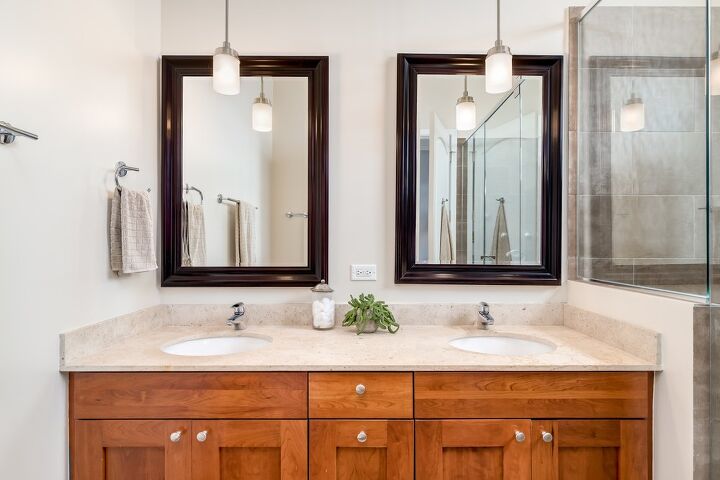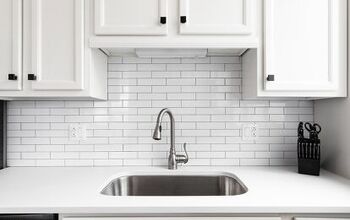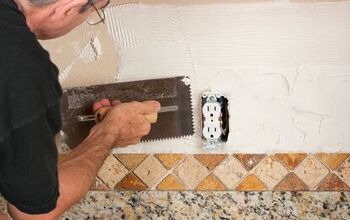Does A Bathroom Vanity Need A Backsplash?

A 4-inch backsplash that matches the granite surface was included with my bathroom vanity. Since the backsplash isn’t really exciting to look at, I questioned if I even needed it and whether it would be good to remove it.
You need a backsplash for your bathroom vanity unless it is a pedestal sink that rests apart from the wall. The practical explanation is that a bathroom backsplash guards against decay, mildew, and mold on the wall behind the sink. A backsplash can also add a lot of visual appeal.
We’ll start with the utilitarian benefits of a vanity backsplash before examining how it can improve the aesthetics of your bathroom.
Can You Have a Bathroom Vanity Without a Backsplash?
Using a moisture meter, a contractor assesses the amount of moisture in the walls. A contractor checks for water damage with a moisture meter after removing the bathroom vanity.
Similar to being outside in a downpour without an umbrella, picture your bathroom vanity without a backsplash. After all, the wall behind your sink is almost certainly repeatedly splashed. Other wet bathroom activities include face washing, tooth brushing, and hand washing.
We’ll start with the utilitarian benefits of a vanity backsplash before examining how it can improve the aesthetics of your bathroom.
Warp and Rot
If your vanity is unprotected by a backsplash, moisture will pool in the drywall. It may seem innocent, but that’s not the case. In fact, if the drywall has decayed or warped, you usually won’t notice until it’s too late.
Mold and Mildew
Even worse, there may be a concealed mold or mildew problem with the drywall. In this scenario, the mold will develop unnoticed and may spread to other parts of the house without your knowledge.
Bathroom mold not only poses a health risk to the occupants, but it may also be very expensive to remove.
Your Vanity Backsplash: Prevention
As the saying goes, prevention is always preferable to treatment. This crucial plan includes a backsplash for the bathroom vanity.
Bathroom Vanity Backsplash Height
A bathroom vanity backsplash needs to be at least 4 inches wide and extend from the countertop. The wall behind your bathroom sink or sinks will be shielded from damage by doing this. However, a taller backsplash can be required depending on the height of your faucets.
4-Inch Backsplashes are Standard
Many vanities come with the 4-inch backsplash. Furthermore, many shops would presume that you want this as part of your vanity purchase. Given that, if you have any other plans, you might wish to mention them.
For instance, you can decide to utilize a backsplash made of a different material than the countertop’s material or buy a faucet that is higher than 4 inches. Inform your showroom if this is the case that you do not require the vanity’s included backsplash. (Try to use that as leverage to slightly lower the price.)
You’ll need a backsplash that matches the faucet height if your faucet spout is higher than 4 inches. For instance, Roman and Waterfall faucets may give any bathroom a regal and spa-like aesthetic feature. The best bathtub faucet for your bathroom may be found here.
These faucet varieties, however, can extend up to 8 inches from the vanity surface and are higher than 4 inches. Therefore, you would need a minimum of an 8-inch high vanity backsplash for these types of faucets.
Even while a 4-inch-tall backsplash could work with a bathroom faucet that is normal in height, you might not desire that.
Why? Because adding even a few extra inches to the backsplash’s length can make your bathroom design feel higher-end and more personalized.
Countertop-to-Ceiling Bathroom Backsplash
Think about extending the backsplash all the way up to the ceiling. Even while it’s doubtful that you’ll ever need such a high backsplash behind a bathroom sink, the addition can not only make the area look more elegant, but it can also give the room an impression of being richly layered.
Floor-to-Ceiling Bathroom Backsplash
For constructing a modern, spa-like bathroom, many bathroom designers believe that a floor-to-ceiling backsplash or wrap-around tiling is the best option. According to bathroom designer Kathleen Finley, “I prefer to tile from floor to ceiling if at all possible since it represents the ultimate in luxury.”
What Materials are Used for Bathroom Vanity Backsplash?
A bathroom vanity backsplash can be made from a huge range of materials. You should choose a material that is both waterproof and hygienic. Let’s examine some of the more well-liked choices.
Ceramic
Ceramic tile is not only lovely but also reasonably priced. Designer Kathleen Finley demonstrates how to use ceramics to produce a “Wow!” effect.
Use a neutral hue for the bathroom’s entire interior, she advises, and then use an accent tile for the backsplash behind the vanity.
Glass Mosaic Tile
For a backsplash, you may discover some stunning, eye-catching glass mosaic tiles. Naturally, the glass’s sheen allows for the creation of a brilliant accent atop the bathroom vanity. Even a 4-inch glass backsplash can be stunning with the right amount of pizzazz.
Marble
Marble gives any room a fair sense of opulence. Think of installing a backsplash on the wall that matches the countertop’s marble surface. If you go to the showroom, you can choose a marble slab that is lovely and can extend up your wall the desired height.
When it comes to marble, more is frequently better! Natural stone includes marble. It needs to be sealed, and because it cracks easily, maintenance may be more difficult than with other materials. Additionally, it is usually more expensive.
Granite
The most typical material for bathroom vanities is granite. Additionally, a 4-inch matching granite backsplash is included with your regular granite vanity. This makes it appear uninteresting. However, granite is also attractive and simple to maintain.
Choose a slab from the showroom for your countertop and think about a backsplash that is higher than typical to match if you want to go for a more personalized appearance.
Or, to add an additional layer of mystery, consider creating a backsplash out of granite and another type of textural tile, such as a glass mosaic.
Wainscot
Wainscot is a common sight in living rooms and libraries. The 18th century saw the peak of this ornate paneling’s popularity. It may be a good idea to display it in your bathroom, provided you pick a moisture-resistant variety.
You may discover wainscoting made of ceramic or PVC plastic, both of which will serve to give your bathroom a majestic flare and protect the walls at the same time.
Metallic Tile
Luxury bathrooms are increasingly using metallic tiles. These include, among others, tiles made of copper, titanim, iron, and stainless steel.
Although metallic tile can have a stunning appearance after installation, it may need sealing and continuous upkeep to maintain the original shine.
Waterproof Wallpaper
Even waterproof wallpaper can serve as a backsplash and provide you with the desired floor-to-ceiling extension at a lower cost than utilizing tile. For a spa-like feel, think about choosing textured wallpaper in a neutral color.
Mirror Backsplash
An attractive backlash can be provided by a mirror that lays flush to the vanity, provided you’re willing to clean it more frequently. Either a 4-inch high mirror strip or the entire ceiling can be used. User decision.
Window or Tempered Glass
If your bathroom is fortunate enough to have a window—or several—you can decide to use the window as a backsplash for your vanity. A window can offer a beautiful view and is simple to clean.
If you have young children and are concerned about someone falling and hurting themselves, you can alternatively use tempered glass or glass brick. Read Should a Bath Be Under a Window? for a lot more details regarding utilizing glass in the bathroom.
Mixing Materials
There is no prohibition against utilizing two or more materials to create a layered backsplash look for your vanity countertop and backsplash. In contrast to the generic vanity backsplash that comes with most vanities, the contrast can offer a striking, rich experience.
Matching the Backsplash to the Vanity Countertop
You can have a difficult time trying to match an existing vanity countertop to a backsplash, especially if the vanity counter is made of granite or another natural stone. Because no two slabs are identical, it may be better for you to visit several stone fabricators in person.
You can bring a picture of your current vanity with you, but to discover the perfect match, you’ll probably need to bring home a few samples. To discover the closest match, consider the natural stone’s striation in addition to its color and tint.
Choose a complimentary glass or ceramic tile for your backsplash instead to save time (and possibly some hassles). However, if you’re determined on matching to your current vanity, be ready to put in the necessary detective work.

Heather is a passionate writer who loves anything DIY. Growing up, she learned everything from home repairs to design, and wants to share her tips with you. When she's not writing, she's usually hiking or searching for her next DIY project.
More by Heather Robbins



























